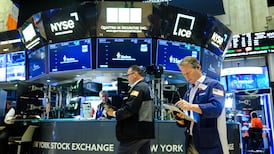THE BANKRUPTCY status in Northern Ireland of former billionaire Seán Quinn has been annulled by the High Court in Belfast.
The Irish Bank Resolution Corporation, formerly Anglo Irish Bank, will now seek to have Mr Quinn (65) declared a bankrupt in the Republic.
A person can emerge from bankruptcy in one year in Northern Ireland whereas in the Republic, it takes 12 years.
Mr Justice Donnell Deeny, in a reserved judgment, said he accepted the argument of IBRC that Mr Quinn’s centre of main interest was in the Republic and not in Northern Ireland, as had been claimed by Mr Quinn when he successfully applied for bankruptcy status in November. Mr Quinn told the court then that he had assets of £50,000 (€60,500). State-owned IBRC claims he owes the bank €2.88 billion.
In the case before Mr Justice Deeny, Mr Quinn claimed he had been using an office in a business park in his native Derrylin, Co Fermanagh, since May 2011, just weeks after IBRC seized the Quinn Group.
He produced for the court a lease signed by him and dated May 2nd. He also produced for the court an invoice dated July 7th, 2011, from Print In Time printers, in Tallaght, Dublin, for headed letters and business cards showing the Derrylin address, and submitted to the court copies of headed notepaper, business cards and a compliments slip, showing the Derrylin address.
Mr Justice Deeny said the lease was a “somewhat curious document”. It was headed “commercial lease” and gave the impression that it might have been drafted by a solicitor, but no solicitor had averred to having drafted it or had witnessed it.
The rent for the office was £50 a month, which seemed close to a peppercorn rent, Mr Justice Deeny said. This would not be inconsistent with Mr Quinn’s statement that the lessor, local businessman and plant hire operator Michael Brady, provided the office space as a gesture of friendship and loyalty to Mr Quinn, who had brought so much employment to the area.
“But if the office is being provided on that basis, why have a commercial lease at all?”
Mr Justice Deeny also noted that the printer’s invoice included no reference to compliments slips although one had been handed in, nor had he been given any example of a letter sent on paper headed with the Derrylin address.
Taking into account the submissions made to the court, he concluded “on the balance of probabilities, that this lease has been prepared at some much later date to try and bolster the case now being made.
“If the invoice for letterheads and visiting cards is genuinely dated, it is likely that it refers to other letterheads and cards than the ones furnished to the court.”
Mr Justice Deeny observed that although the lessor’s signature “appears to be on the lease, it is not inevitable that it bore the date it now bears at the time that he signed it”.
He rejected the claim that the Derrylin office was where Mr Quinn administered his main interests on a regular basis at the time he made his bankruptcy petition to the courts.
He said Mr Quinn had also made some omissions at the time of his ex parte application for bankruptcy which were material.
After the ruling, Gabriel Moss QC, for the bank, sought costs against Mr Quinn and also sought an order that Mr Quinn disclose who was paying his costs. The bank might then consider seeking to recoup its costs from that party, he said. He said Mr Quinn was now “bound to be made bankrupt in the Republic”.
Mark Orr QC said Mr Quinn had not been asked who was paying his costs.
Mr Justice Deeny made an order for costs against Mr Quinn who, he observed, was not now a bankrupt. He suggested that the bank write to Mr Quinn asking that he identify who was paying his costs. An approach could then be made to the court in the matter.











